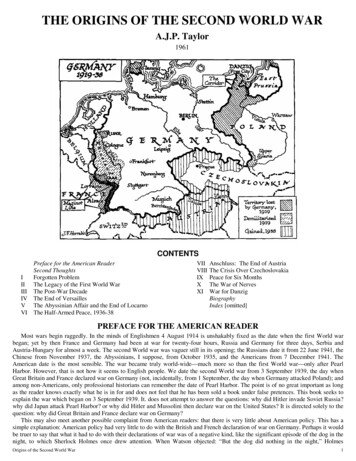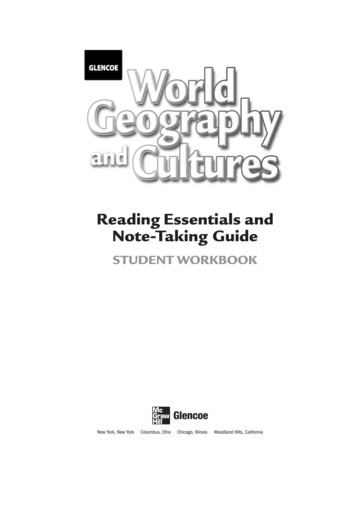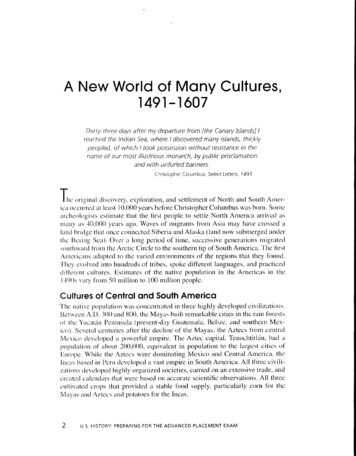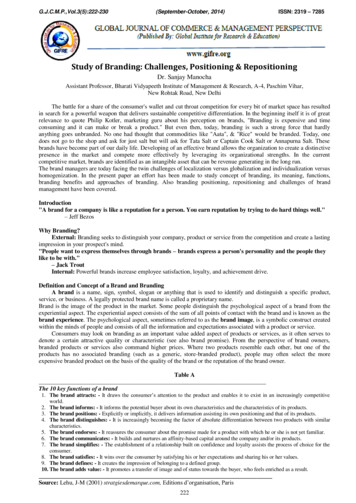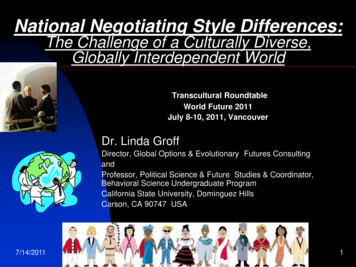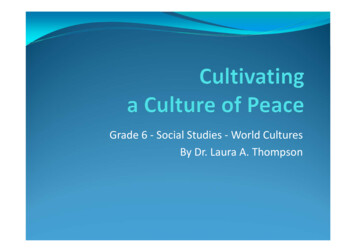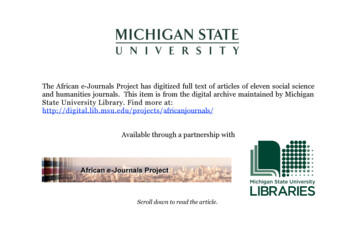
Transcription
ALL YE LANDSOrigins ofWorld CulturesContributorsEllen RossiniCarl RossiniRollin LasseterAnne CarrollChristopher ZehnderMary O. DalyGeneral EditorRollin A. LasseterProduced and developed by:Catholic Schools Textbook ProjectIn cooperation with:Ave Maria University
Table of ContentsPrefaceviiIntroductionviiiChapter 1Introduction to Geography1Chapter 2Prehistory: Beginning Man’s Story21Chapter 3The Mission of Israel47Chapter 4The Marvelous Greeks69Chapter 5Eternal Rome95Chapter 6The Christian Church: A Gift from God115Chapter 7Byzantium and the Rise of Islam147Chapter 8Europe: The Middle Ages169Chapter 9Chapter 10Europe: The Renaissance, the Reformation,and the Modern WorldChina: The Middle Kingdom207229Chapter 11Japan: Land of the Rising Sun257Chapter 12India: The World of the Rajas275Chapter 13Africa: The Enduring Continent299Chapter 14Russia: The “Third Rome”323Chapter 15North America: Land of Opportunity347Chapter 16Latin America: Lands of Many Cultures373Index409v
******************Chapter 1Introductionto GeographyGod’s Creation, God’s GiftWhen you read a story, do you ever try to imagine yourselfat the side of the main character, in the places the storydescribes? Have you ever, for instance, pictured yourselffloating on a raft down the Mississippi with HuckleberryFinn? Hiding with Robin Hood in Sherwood Forest? Climbing the snowcovered Alps with Heidi? Walking the foggy London streets with SherlockHolmes? A good writer can often make you see theseplaces with your imagination, even though you havenever seen them with your eyes. And in seeing theseplaces in your mind, you enjoy the story more.What about the stories of history? When you listento the story of the Israelites crossing the Red Sea intheir exodus from Egypt, do you wonder how wide thissea was and where they crossed? Do you wonder whythe Promised Land was called the “land of milk andhoney” in the Bible when it is seems so barrenand sandy now? Do you ask where the Rubicon is thatJulius Caesar crossed to become ruler of Rome? Do youpicture with your mind’s eyethe battlefield at GettysburgAn enhanced photo ofwhere Robert E. Lee and theEarth taken from spaceSouthern cause went downin 1972 by the Apollo 17in defeat?astronauts during theirmission to the moon1
2All Ye Lands: Origins of World Culturesfertile: producingcrops easilyThe physical features of a place (its terrain, landscape, mountains,rivers, seas) often shape how a people lives — such as whether it will benomadic, wandering from place to place like the Indians of the plains,or whether its people will become merchants, buying and selling on theMediterranean Sea. And how a people lives shapes history.So it is that knowing more about the physical places where historywas made can deepen your understanding of history. It can also help youenjoy the studying of history more.All these physical places where history has occurred make up ourremarkable planet called Earth, created by God to be our first home onthe journey to heaven. The planet Earth is ours to enjoy and share. Its different environments range from the fertile farmlands of central Europeto the volcanic islands of Japan, from the ice-covered poles to the hot andhumid tropics. It is a gift we are to take care of, enjoy, improve, and passon to future generations.Earth WritingThe study of Earth — including its land and landforms, rivers and seas,and the people that have carved out homes in its various regions — iscalled geography. This word comes from Greek: geo for “Earth,” and graphfor “writing.” Geography is thus a “writing about” or description of theEarth. By learning how to read this “earth writing,” by learning how todescribe the world you live in, you will make better sense of the stories inthis book and other books. People and events will fill your imagination.When you read, you will travel; and when you travel, you will read, seeingthe past in a landscape that does not change much over time.Reading MapsPeople have always had uses for geography, especially those useful toolsof geography called maps. Maps are drawings (usually flat) of the worldor certain places on it. In one form or another, maps have existed sincethe earliest civilizations, for people have always been eager to describewhere they are or what belongs to them or to someone else. Travelers,for instance, may want to know how far they have gone on a journey,or where they are in relation to a certain river, mountain, or town. An
Chapter 1 Introduction to GeographyR U SS IA45 NHokkaidoCHI NANWNORTHKOREA3Map of the islands ofJapan, showing latitudeand longitude lines, anda color-keyed elevationscaleES e aSo f40 NJAPANJ a p a nP a c i f i cO c e a nElevationSOUTHKOREAHonshu 12,000 feet9,000–12,000 feet7,500–9,000 feet6,000–7,500 feet35 N4,500–6,000 feet3,000–4,500 feet1,800–3,000 feetShikokuKyushu1,200–1,800 feet600–1,200 feet300–600 feet0250 miles0250 kilometers150–300 feet0–150 feet30 N130 E135 E140 E145 Eowner of property or the king of a nation may want something to showthe boundaries of his property or his kingdom. A student of history willwant to know not only what happened during a certain time period, butwhere it happened as well. For these, and other purposes, maps are veryuseful tools.Depending on what their purpose is, maps show us different things.Some may just indicate the physical characteristics of a place (mountains,valleys, rivers, lakes, etc.) — what we call physical geography. Othersmay show the location of cities, towns, and indicate boundaries betweennations and states — that is, they show political geography. Most mapsshow both physical and political geography, for they are very much connected with one another. Nations, for instance, have often used rivers ormountain ranges to mark their political boundaries, and the junctions ofrivers have served as the sites for the building of towns and cities.physical geography:a description of theformations of the Earth(mountains, valleys,rivers, lakes, etc.)political geography:a description of theboundaries of statesand regions, the location of cities andtowns, and otheraspects of human society that have to do withgeography
4All Ye Lands: Origins of World CulturesMercator Projection—A map showingthe meridians parallel to each otherand the lines of latitude spaced farther apart as their distance from theEquator increases. This kind of map isespecially useful for sea navigation.Robinson Projection—A map showing shapes and areas more accurately than other maps. The polesare shown as lines, not points.Lines of latitude are straight, andmeridians are curved and get closeras they approach the poles.Maps come in two forms — globes and flat maps. Globesare maps of the entire Earth, showing the continents,islands, oceans, and other features just as they would appearto us if we could see Earth in space. Flat maps show parts ofEarth, or the entire earth, but in a way that it does not looklike they belong to a sphere.Flat maps, especially of the entireearth, do not show the variousfeatures of Earth as accurately asglobes. On a flat map, for instance,Greenland may appear larger thanAfrica, when it is actually quitesmaller. This is a problem withtransferring the rounded surfaceof the globe to a flat surface. Todo so, one must make the areas atthe top of the map appear largerthan they are. Such a flat map iscalled a Mercator Projection, after itsinventor, Gerardus Mercator (1589).Today, some maps try to correctthis problem by drawing Earth ina rounded shape and depicting thepoles as lines, not points. Such a mapis called a Robinson Projection.A book of maps is called an atlas,a name that comes from ancientGreek mythology, which tells ofa giant named Atlas who held upthe sky. Early mapmakers liked todraw Atlas underneath a map of theworld that he appeared to carry onhis shoulders.You will often hear someone speak of “reading” maps.People speak this way, because maps have their own “language.” Maps use symbols that, just like words, convey ideasto those who “read” them. These symbols are the compass rose,the legend or key, scale, direction, and latitude and longitudelines. We will now describe each of these symbols in turn.
Chapter 1 Introduction to GeographyThe Geographical Directions5North PoleEarth is a sphere that spins as it moves around the sun.Of course, that is not what our immediate senses tellus, but what scientists have discovered over theNORTHlast several centuries. The Greeks, and possiblycAMERICAAtlantithe Egyptians, knew Earth was a sphere, but theythought it stood still and the heavenly bodiesPacificmoved around it. They did not think Earth movednaround the sun.OceaEquatorThe imaginary line that passes through EarthOceanaround which Earth spins is called Earth’s axis.SOUTHThe ends of the axis are called poles — the NorthAMERICAPole and the South Pole. As Earth spins, the sun’slight (day) moves over half the earth. It appears tous that the sun “rises” in the morning and “sets” in theevening. What really happens is that where we are onEarth has moved into the sun’s light or out of it asSouth PoleEarth spins.Globe showing the North and South PolesWe give directions based on where the sun rises,where it sets, and on the North and South Poles. Thedirection where the sun rises is called “east,” whileaxis: the line aroundthe direction where the sun sets is called “west.” It has become the customwhich a body rotatesto draw our maps with the north at the top (the North Pole) and the eastlatitude: an imaginaryon the right.line used by mapmak-Latitude and LongitudeLatitude and longitude are the imaginary lines used by mapmakers toshow places on a map, or by sailors and other travelers to learn where theyare on the earth. (Longitude lines are called meridians.) These imaginarylines crisscross the globe. Latitude lines run from east to west, while longitude lines run from north to south. The crisscrossing of latitude andlongitude lines is the chief way of showing a location on the map.The latitude line that circles the center of the globe is the equator. Itruns halfway between the north and south poles. All other latitude linesare parallel to the equator. We number latitude lines in degrees based onhow far they are from the equator and how close they are to one of thepoles. The equator we say is zero degrees latitude, and the North Pole,ers to indicate a distance north or south ofthe equatorlongitude: an imaginary line used by mapmakers to indicate adistance east or west ofthe prime meridianmeridian: a longitudelineequator: an imaginarycircle equally distantfrom the two poles,around the middle ofthe earth
6All Ye Lands: Origins of World CulturesLatitude and longitudelines, as seen on a globe75 NNorth Pole (90oN)North Pole (90oN)180 meridian60 N45 N30 N90 WEquator15 S(0o)75 W60 W90 E30 S60 SSouth Pole (90oS)prime meridian:the only great circleof Earth that passesthrough both poles andthe Royal Observatoryin Greenwich, England.All other meridians arenumbered from thismeridian, which is the0 (degree) meridian.Equ at or45 W45 SPrime meridianLongL atitud e0 itude15 N30 W15 W75 E60 E45 E0 15 E 30 ESouth Pole (90oS)90 degrees (90 ) north latitude. Since the South Pole is the same distance from the equator as the North Pole, but on the opposite sideof the earth, it is 90 (90 ) degrees south latitude. A latitude line lyingbetween the equator and one of the poles will have a number somewhere between zero and 90 degrees. For instance, the line that runsthrough Beijing, in China, and Philadelphia, in the United States, is40 north latitude. The line that runs through Sydney, Australia,is 34 south latitude. If regions have the same latitude, their climatesmight be the same.We also measure longitude in degrees; but, instead of the equator, weuse a line called the prime meridian as our longitude line or meridian of0 . The prime meridian runs from the North to the South Pole and passesthrough Greenwich, England. Really, any longitude line could be used asthe prime meridian, but in 1884, 25 nations agreed to make the Greenwichmeridian the prime meridian. The meridian that runs near Rome, Italy,(west of the prime meridian) is 12 west longitude. The meridian thatruns through New York City (east of the prime meridian) is 74 eastlongitude.If you started at the prime meridian and traveled westward around theworld, you would cross meridians that increase in number. That is, youwould go from 0 meridian, through the meridians numbering 10 , 50 ,100 , etc. When you reached 180 meridian (which passes through thePacific Ocean), you would begin to pass through meridians that decreasedin number. That is, you would go from 180 to 150 , 100 , 50 , and 10 meridian. Eventually you would arrive back at the prime meridian.
7Chapter 1 Introduction to GeographyMap DirectionsMost maps are so drawn that north is at the top of the map as you look atit, south at the bottom, west to the left, and east to the right. Some maps,however, may place a different direction than north at the top, so it isimportant to find on the map what is called the compass rose — a smallcircular symbol that looks like a sun with four long rays shaped like across. Each ray will point to a direction, indicated by the letters N (north),S (south), E (east), or W (west). Wherever the N ray points is north forthat map.NWESLegend or KeyBecause a map is a small picture of a large area, it can include symbolsto represent geographical places or features. These symbols will often befound on the map in a small box called a legend or key. A blackened triangle may stand for a mountain and a crooked line for a river or boundary.A dot is usually a city; the larger the dot, the larger the city it represents. Abroken line or lines with arrows can show someone’s travels or an army’sinvasion route.MAP LEGENDMountainTravel routeCityRiverCity boundaryFigure AScaleThis is a horizontal bar that can be used to showdistances on maps. The scale on a map will appearas a straight line, marked by smaller cross linesthat indicate various distances. The scale shownin Figure B indicates a distance of 100 miles, alongwith distances (25, 50, 75 miles) between zero and100 miles.A string can be used with the scale to figureout distances between places on a map. If, forinstance, you want to discover the distance betweenSan Francisco and Los Angeles, California, youwould place one end of the string, say, whereSan Francisco is on a map and pull out as muchstring as you need to reach Los Angeles. By measuring the string length with the scale, you will beable to determine the distance between the two cities.San FranciscoCALIFORNIAPac ificO c eanLos Angeles00Figure B25 50 75 100 miles100 km
8All Ye Lands: Origins of World CulturesOur Moving Continentstectonics: geologicalfeatures of Earth’s crustEarth’s crust: the solidouter part of the planetAbout a hundred years ago, scientists of the earth’s history learned something that changed the way everyone thinks about geography. They foundthat, like puzzle pieces, rock cliffs in South America match and fit cliffssimilar to them in Africa. This discovery led scientists to suspect that allthe lands of the earth were once one huge landmass above water and that,over millions of years, that landmass broke apart and its different sectionsdrifted away from one another. This theory has thus been called “continental drift.” It is also called “plate tectonics,” because each of the greatsections of Earth is called a plate. A plate is an enormous, movable pieceof Earth’s crust.Beneath the oceansare continental plates,which come togetherto form the surface ofthe earth. This mapshows the boundariesof the plates.120 E150 E180 150 W120 W90 W60 W30 W0 30 E60 EArcticOcean75 N75 NNORTH AMERICANPLATE60 NEURASIANPLATEEURASIANPLATEJUAN DE FUCAPLATEAtlanticPHILIPPINEPLATE30 quator0 0 0 SSOUTH AMERICANPLATEOcean060 S150 EIndianAFRICANPLATE30 S180 150 W1,000 milesAUSTRALIANPLATE0 1,000 kilometersPlate boundariesDirection of platemovementsEstimated plateboundary120 E60 NANTARCTICPLATE60 SSCOTIAPLATE120 W90 W60 W30 W0 30 E60 E
Chapter 1 Introduction to Geography9According to scientists, about 120 million years ago, the earth’s greatlandmass began to break up into plates. Some of these plates were alreadybeneath the waters of the oceans; others tipped, throwing up one partof the plate and lowering the other part into the waves. The parts of theplates above the water became continents. A continent is a part of a continental plate that is above water.Over millions of years, the continental plates have moved apart andbeen driven against each other. Great mountain ranges rose up whenthe plates moved against each other; and where they moved apart, oceanwaters flowed in to make new bodies of water. In the short history ofhumankind on Earth, the continents have been just about the same asthey are now. They are moving, but so slowly that we cannot detect it.Only measurements at one or two known plate edges give evidence thatthe theory of continental drift is true.The Seven Continents and Other LandmassesThe movement of the earth’s plates has left three different kinds of landmasses standing above the waters — continents, peninsulas, and islands.The largest of these landmasses are the continents, which are seven innumber: North America, South America, Asia, Europe, Africa, Australia,and Antarctica.Of all the continents, Asia and Africa are the largest, while Australiaand Antarctica are the smallest. On a map it looks as if Europe and Asiaform one continent; but the Ural (YOO-rahl) Mountains, the CaucasusMountains, the Black Sea and the Caspian Sea separate these two continents. The eastern end of Europe is flat and was once covered with denseforests and wide grasslands. The western end of Asia is also flat, as well ascold or desert-like. These physical boundaries prevented travel and keptthe different civilizations that developed on the two continents separate.The two Americas are connected by the bridge of Central Americabetween the southern boundary of Mexico and the isthmus of Panama.Mexico and Central America are parts of North America but are semitropical like most of South America.An island is a body of land surrounded on all sides by water. Greenland,the largest island, is a continental island. A continental island is an islandseparated from a continent by water but connected underwater by oneisthmus: a narrow stripof land, having wateron either side, that connects two large bodiesof land
10All Ye Lands: Origins of World Cultures120 E150 E180 150 W120 W90 W60 W30 W0 30 E60 EArctic Ocean75 N75 N60 NA60 NSIANORTHE U RO PEAMERICAPacific OceanAtlanticOcean30 N30 NAFRICA0 Equator0 SOUTHAMERICA30 SAUSTRALIAAtlanticOceanPacific Ocean060 S30 SIndianOcean1,000 miles60 S0 1,000 kilometersANTARCTICA120 E150 E180 150 W120 W90 W60 WMap of the worldshowing the continents, the oceans,and the equator(a) An isthmus;(b) small tropical island; and(c) KalaupapaPeninsula inHawaii(b)(a)(c)30 W0 30 E60 E
Chapter 1Introduction to Geography11continental plate. Some islands are the tops of mountains rising abovethe waters.A peninsula (from Latin paene, meaning “almost,” and insula, meaning “island” — an “almost island”) is a body of land surrounded on threesides by water, but connected to a larger body of land on the fourth side.Greece and Italy are two large peninsulas jutting into the MediterraneanSea. Spain and Portugal are on the Iberian Peninsula, surrounded by theAtlantic on the west and the Mediterranean on the south and east.Mountains, Volcanoes, Plains, and DesertsThe landmasses of the earth have various features that give great varietyand beauty to our world. We can roughly divide these features into mountains (including volcanoes), plains, and deserts.Mountains are often made by plates shoving up against each other,cracking, and then reconnecting. The surface of the earth is constantlyshifting. Mountain ranges have risen and fallen over the millions of yearsof Earth’s history.The world’s tallest mountain is Asia’s Mt. Everest, soaring 29,000 feethigh above sea level (that is more than five miles) at the border of Nepaland Tibet (which happens to be the world’s largest and highest plateau).Mt. Everest is part of the Himalayas, the world’s largest mountain system,Mount Everest, 29,035feet high, located inNepal, is namedafter the Englishsurveyor, Sir GeorgeEverest.
12All Ye Lands: Origins of World Cultures120 E150 E180 150 W120 W90 W60 W30 W0 30 E60 EArctic Ocean75 NAaSatMoUr al M o un t ain sMnsts.AtlanticOcean 4,800 feetAndes600–1,200 feet300–600 feet150–300 feet0–150 feet120 E150 ETopographical mapshowing mountainranges of the worldwith color-keyedelevation scalemagma: molten rockmaterial beneath theearth’s surfaceobsidian: dark, naturalglass formed by thecooling of molten lava180 150 WSahara DesertArabianPeninsula0Plateauofala TibetyaMts.DeccanPlateau0 SOUTHAMERICAMountains1,200–1,800 feetAUSTRALIAts.AFRICA3,000–4,800 feet1,800–3,000 feet30 SMasAtlsMts.mppalhiElevation0 CaucasuAlpsHiinsA30 NEUROPEAMERICAaitaPacific OceanPlunGobi Desert60 NNORTHkyAoc60 NreIiGrRb eaniacS75 NKalahariDesert30 SIndianOcean1,000 miles0 1,000 kilometers120 W90 W60 W30 W0 30 E60 Ewith eight of the world’s ten highest mountains. The higher mountainranges are the youngest in Earth’s history, though still unimaginably oldby human history. As a mountain range ages, it is worn down by wind andrain and so becomes smaller.Some mountains, called volcanoes, are formed by molten rock andash erupting out of the hot magma beneath the earth’s crust. Breaksin the plates allow the molten rock to pour up to the surface of theearth. Then the molten rock cools and hardens, forming a cone-shapedmountain. Volcanoes surround the Mediterranean Sea and the NorthPacific Ocean.The soil that ash from volcanoes leaves behind is rich and fertile andhas produced some of the best farming land in the world. Human beingshave chosen to live under volcanoes for the rich farmland. Prehistoricman valued the natural volcanic glass, obsidian, since it gave toolmakersthe first material for making really sharp knives and cutting tools.The most famous volcanoes in history are Mt. Vesuvius in southernItaly and Mt. Aetna on the island of Sicily. In a.d. 79, Vesuvius erupted
Chapter 1Introduction to Geography13Mount Vesuvius, avolcano in Italy nearNaples, erupted inA.D. 79, destroying theancient cities of Pompeiiand Herculaneum.and buried the Roman town of Pompeii in ash, leaving a perfectly preserved ancient town for archaeologists to uncover many centuries later.Mt. Fujiyama, a volcano in Japan, has been revered by the Japanesefor its majestic size and beauty. The eruption of Krakatoa in Indonesiaduring the 1890s sent a cloud into the atmosphere that left ash all overthe world.The large, flat areas of the world are called plains. Plains are not trulyflat; they have a rolling surface, but no mountain ranges. Plains have beenhistorically the home of nomadic peoples, who have no settled homesbut follow wandering herds of animals. The plains of eastern Europeand western Asia are huge expanses of thousands of miles of grassland,called steppes. The Great Plains of the North American continent wereonce covered in grasses that grew as tall as a man. Such grasslands arecalled prairies. The plains areas nearer the tropics are too hot to grow tallgrasses, but they support savannahs, lands with low grasses and stands ofscattered trees. Plateaus are plains high above sea level; they are usuallypart of a mountain, where the air is cooler and the winds from the mountains are strong. Central Mexico is a plateau, as are Tibet (north of theHimalayas) and the central portion of India, called the Deccan Plateau.nomadic: of or belonging to a nomad, amember of a peoplethat moves from placeto place with no fixedhomesteppe: dry, level grasslands with few to notreesprairie: a large areaof flat or rolling land,with no mountains andfew treessavannah: grasslandcontaining scatteredtreesplateau: a large area ofhigh land
14All Ye Lands: Origins of World CulturesA desert is land with very little or no water. Human life is difficult in deserts, because they are unfriendly to human travel and development. Africacontains the world’s largest desert, the Sahara, which stretches the wholewidth of the continent. The other major deserts that have affected historyare the Arabian Desert, in the center of the Arabian Peninsula, and theGobi Desert, which cuts China off from the West. In North America,the Southwestern Desert may also have affected history by keeping peoplein the north from invading Mexico and so protecting the developmentof Mexican and Central American civilization. Between the sea and theAndes Mountains on the west of South America are high, windsweptcoastal deserts. The civilization of Peru was protected from invasion bythe difficulty of crossing those miles of barren waste.The Waters: Oceans, Seas, Lakes, and Riverspacific: calm, peacefulMost of the earth’s surface is actually covered by water. On a map it lookslike all the continents are surrounded by one big ocean, which we dividefor convenience into four oceans: the Pacific, the Atlantic, the Indian, andthe Arctic. Besides the oceans, the earth has other bodies of water: seas,rivers, and ice.The largest ocean is the Pacific; it is so large that all the landmasses inthe world could fit into it. The Pacific Ocean is more than 64 million squaremiles, extending from Asia and Australia to North and South America.The Atlantic Ocean is east of North and South America and west ofAfrica and Europe.The Indian Ocean has Africa to the west, Asia to the north, Australiato the east, and Antarctica to the south. The Arab traders sailed across theIndian Ocean to India and Africa and brought their Muslim religion tothe islands of Malaysia at the southeastern tip of Asia.At the top of the world is the Arctic Ocean, encircled by Europe, Asia,and North America. All its waters are frozen much of the year, and a goodpart of the ocean lies under the northern ice cap all year round.As you can see by looking at a map, the lands of the continents canenclose parts of oceans. The parts of the oceans enclosed by land arecalled seas. Seas are large bodies of salt water. Some are connected tothe larger oceans and are surrounded by land on three sides. Othersare really saltwater lakes, such as the Aral and Caspian Seas in Asia, oreven large freshwater lakes, such as the Sea of Galilee. Though smallcompared to the oceans, these seas have nevertheless been important in
Chapter 1120 E150 EElevation75 N60 NAS–1,609–0 feet–3,218– –1,609 feet–4,827– –3,218 feet–6,436– –4,827 feet–8,045– –6,436 feet–9,654– –8,045 feet–11,263– –9,654 feet–12,872– –11,263 feet –12,872 feetI180 150 W120 W90 W60 W15Introduction to Geography30 W0 30 E60 EArcticOcean75 NNorwegian Sea60 NBering SeaNORTHAEUROPEAral SeaAMERICAAtlantic30 NPacificMediterranean SeaCaspianSeaSeaofGalilee30 NAFRICAOcean0 0 Ocean30 SIndianSOUTHAMERICAOceanAUSTRALIA30 S060 S1,000 miles60 S0 1,000 kilometersANTARCTICA120 E150 E180 150 W120 W90 W60 W30 Whistory. Freshwater bodies of water surrounded by land are called lakes.Lakes can be small or as large as some seas — such as the Great Lakes ofNorth America.A student of history should be able to find the Mediterranean Sea on amap. Our Christian civilization began in the lands about its shores. TheMediterranean (from Latin words meaning “in the middle of land”) is surrounded by the three continents of Europe, Asia, and Africa. The ancientpeoples of Phoenicia (foh-NEE-shah) and Greece traveled this sea and earlyon brought Europeans to the north coasts of Africa. The MediterraneanSea drawn on a map has been said to look like a winged sea horse.The body of water called a river is found on every continent exceptAntarctica. A river is a large stream that carries fresh water into an ocean,lake, or another river. Rivers are essential to life because their water is0 30 E60 EWorld map showingseas, oceans, lakes,and rivers, with anelevation scalekeyed to the colorsof the map
16All Ye Lands: Origins of World Culturesirrigation: the supplying of land with water,especially for growingcropsdrinkable and can be used for irrigation. It is fresh water, unlike the saltwater of oceans.The world’s longest river is the Nile River in Africa; it gave life to thecivilization of the ancient Egyptians. The Amazon River in South Americais the second longest, although it carries more water than the Nile. Atsome places, the Amazon is so wide you cannot see across it. The YangtzeRiver in China is the longest river in Asia; the Mekong of SoutheastAsia is the second longest Asian river. The Mississippi River is the longestriver in the United States, and combined with the Missouri River thatflows into it, is one of the longest rivers in the world. The Danube Riverand the Rhine River are the longest rivers in Europe; they form the centerof much of the continent’s history. The great river valleys of the worldhave been the most hospitable to human life. The first human civilizationsbegan in valleys through which ran rivers with their life-giving waters.Much of the world’s water is frozen. The two poles of the planet arecovered with thick layers or caps of ice. These ice caps are called theArctic (North) and the Antarctic (South) ice. The southern continent ofAntarctica carries a mile-thick ice cap. The Arctic ice cap is just as thickbut smaller in area.Rivers of ice form in certain high mountain ranges — the Alps, theHimalayas, and the Canadian Rockies — and are almost as huge and thickas the ice caps. The ice rivers are called glaciers. During the long periods ofprehistory, called the Ice Ages, the northern ice cap grew or shrank in size,and glaciers descended from it over the continents of Asia, Europe, andNorth America, pushing animal life into the central par
World Cultures Contributors Ellen Rossini Carl Rossini Rollin Lasseter Anne Carroll Christopher Zehnder Mary O. Daly General Editor Rollin A. Lasseter Produced and developed by: Catholic Schools Textbook Project In cooperation with: Ave Maria University. Table of Contents Preface vii Introduction viii C



